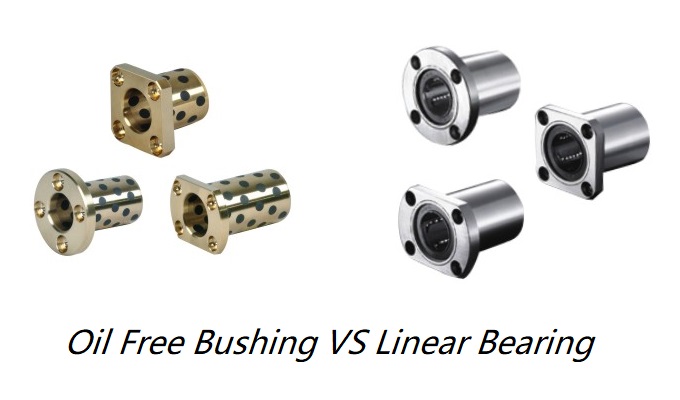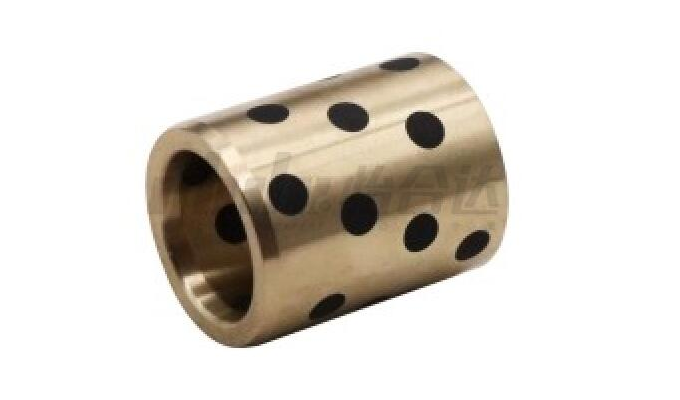Self-lubricating bearings, as essential mechanical components, provide convenient solutions for various applications. Self-lubricating bearings' design and material selection enable them to operate smoothly without the need for external lubricants, reducing maintenance costs and operational complexity.
I. Features of Self-lubricating Bearings
Lubrication can be categorized into fluid lubrication, mixed lubrication, boundary lubrication, and solid lubrication. In the realm of solid lubrication, bearings with excellent friction characteristics and wear resistance are referred to as self-lubricating bearings. These bearings are utilized in stable conditions where lubricants cannot be applied or are scarce, such as boundary lubrication and mixed lubrication areas. Consequently, these self-lubricating bearings are also known as "self-oiling bearings" or "dry bearings."
Self-lubricating bearings features:
- Low friction: When using solid lubricants, the direct friction between solids results in a low friction coefficient.
- Heat resistance: Solid lubrication exhibits a smaller friction coefficient compared to fluid lubrication, enabling the bearings to withstand the high heat generated by this direct friction between solids.
- Sinterability: Resistant to sintering.
- Wear resistance: Not easily worn down.
- Environmental adaptability (corrosion resistance): Can withstand the chemical corrosion caused by air, gases, and working fluids.
Ⅱ. Types of Self Lubricating Bearing Materials
Classification of Self Lubricating Bearing Materials
Self-lubricating bearing materials refer to those that exhibit low friction characteristics even without external lubricants. Representative examples include plastic bearing materials containing solid lubricants such as graphite and molybdenum disulfide dispersed in plastics like polytetrafluoroethylene (PTFE) resin. Additionally, there are materials synthesized from solid lubricants and metals, bearing materials with graphite added to metal substrates, and even unique cases like natural and rubber-based bearing materials. Broadly, oil-impregnated materials where lubricating oil is infused into the material are also categorized as self-lubricating bearing materials.
1. Plastic Bearing Materials
Self-lubricating bearing materials include the most common options. Plastic bearing materials are divided into categories such as solid lubricant dispersion materials, double-layer materials, composite materials, and porous materials. Solid lubricant dispersion materials involve dispersing solid lubricants like graphite, molybdenum disulfide, and lubricating oil into plastics. These materials are then formed through processes like injection molding and compression molding, offering the advantage of being easily machinable into various shapes.


a. Solid Lubricant Dispersion Materials
Plastic bearing materials are the most widely used in various applications. They involve dispersing solid lubricants like graphite, molybdenum disulfide, and PTFE resin, along with lubricating oil, into plastics. These materials can be sprayed and compressed into shape and can be processed into various shapes using mechanical methods.
b. Double-Layer Materials
Double-layer materials consist of a metal lining, a sintered metal powder layer, and a plastic layer. Due to their double-layer structure, they quickly dissipate heat generated by friction and compensate for the weaknesses and self-heating conductivity of plastics. Compared to solid lubricant dispersion materials, double-layer materials are high-performance bearing materials that exhibit good tolerance even under high-load conditions.
c. Composite Materials
Composite materials involve forming a resin, molybdenum disulfide, and other solid lubricants directly onto the surface of basic materials like metals. These materials are used in specific areas where optimization of surface properties and sliding characteristics is required. They impart coated characteristics to various components.
d. Porous Materials
Porous materials are bearing materials where materials like PTFE resin are infiltrated into the pores of metals. These materials are inserted between shafts and bushings to reduce play and prevent shaft loosening. The presence of resin (PTFE) allows for a low friction coefficient.
The primary component of the aforementioned materials on the friction surface is plastic. These materials include thermoplastic resins such as PTFE, polyimide, polysulfone, and thermoplastic copper-based resins, as well as thermosetting resins like epoxy, phenolic, polyimide, and polyamideimide. By selecting these materials, bearings can be used under a wide range of lubrication conditions, including lubricating oil, grease, and even water, making them suitable for diverse applications.
2. Other Self-Lubricating Bearing Materials
Apart from plastic-bearing materials, there are solid lubricant dispersion materials synthesized from solid lubricants and metals, solid lubricant-filled bearings with materials like rod-shaped graphite embedded in copper alloys, and oil-impregnated sintered bearing materials made by infusing lubricants into copper and iron alloys. Additionally, there are specialized materials like wood-based bearing materials and rubber-based bearing materials.
Ⅲ. Types of Self Lubricating Bearings
1. Gas Lubricated Bearings
Gas lubricated bearings are sliding bearings that utilize gas as the lubricant. Commonly used gas lubricants include air, nitrogen, argon, hydrogen, helium, and others as required. The mechanism for forming the bearing film in gas lubricated bearings is similar to that of liquid lubricated bearings. Gas lubricated bearings leverage the diffusion coefficient, viscosity, thermal conductivity, absorption, and compressibility of gases. Under the effects of fluid dynamic pressure, static pressure, and squeeze effects between friction pairs, a complete gas film is formed, which supports loads and reduces friction.
Gas lubricated bearings are generally categorized into three types: gas dynamic bearings, gas static bearings, and gas squeeze bearings. In actual bearings, lubrication states often exist in a mixed lubrication state of dynamic, static, pressure, dynamic, squeeze, static, squeeze, and dynamic, static, squeeze. The mechanism for forming the bearing film in gas lubricated bearings is similar to that of liquid lubricated bearings.
2. Composite Material Lubricated Bearings
In some critical equipment of industrial and mining enterprises, specific production processes and harsh operating conditions present challenges. These include heavy equipment, high ambient temperatures, and the presence of dust or corrosive gases in the air. Lubrication of such equipment poses numerous issues, leading to severe friction and wear problems. Most often, traditional oils and greases are employed, which fall short of meeting the demands of these extreme conditions. Such lubricants are prone to causing biting or smearing of bearings and other friction pairs, leading to severe wear of components and frequent equipment downtime.
Composite material lubricated bearings from self lubricating bearing manufacturers are a novel type of high-pressure-resistant solid lubricating material. They consist of a metal substrate and a solid lubricating paste embedded in holes or grooves on the substrate. During friction, the metal substrate bears most of the load. Following friction, the solid lubricant within the holes or grooves transfers or reversely transfers to the friction surface, forming a well-lubricated, firmly adhered, and evenly distributed solid transfer film on the friction surface. This significantly reduces friction and wear. As friction progresses, the embedded solid lubricant continuously supplies the friction surface to ensure effective long-term lubrication of the friction pair.
3. Water Lubricated Bearings
Since the petroleum resource crisis in the 1970s and the recent emphasis on environmental protection, hydraulic transmission technology has faced significant challenges, leading to the gradual adoption of water lubricated bearings. Water lubricated bearings that employ water as both the lubricant medium and working medium not only conserve a substantial amount of oil but also mitigate the environmental pollution caused by traditional oil-lubricated bearings. Additionally, water, with its advantages of wide availability, safety, and non-flammability, is an ideal lubricant medium. Furthermore, water can reduce critical issues such as friction, wear, vibration, noise, and non-functional losses in friction pairs.





